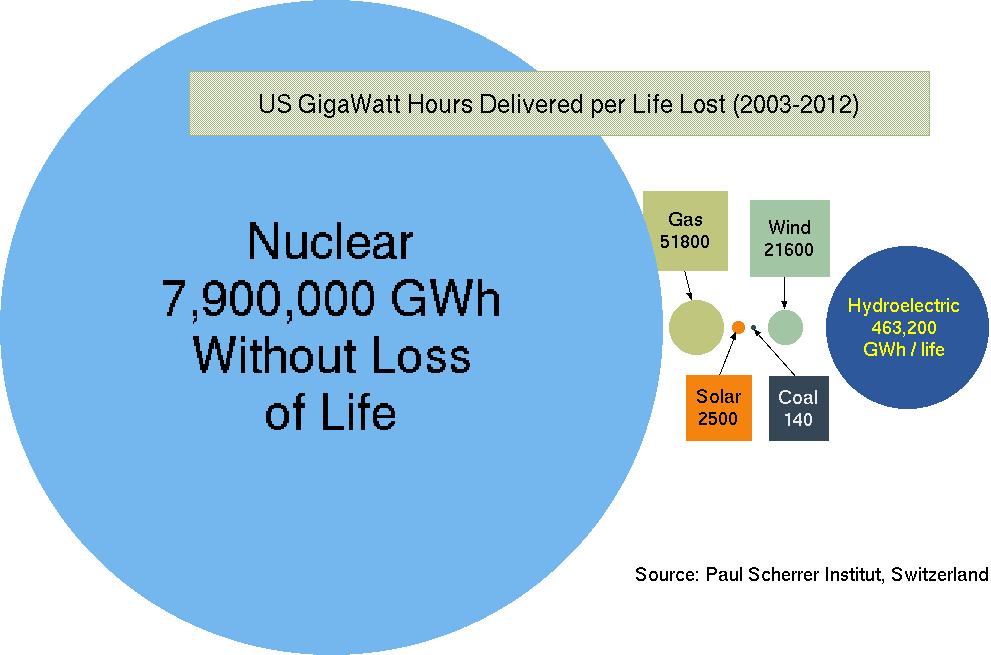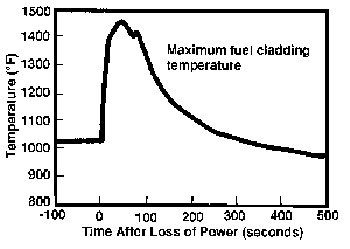 |
The Paul Scherrer Institut in Villigen PSI, Switzerland is a frequent European Community consultant concerning safety. Their collection of more than 33,000 records of accidents related to electricity production shows that nuclear power is the safest-ever way to make electricity, by a very wide margin. Only 46 fatalities are directly attributed to municipal nuclear power in its entire six-decade worldwide history, all at Chernobyl.
There have been only 46 fatalities in the entire six-decade worldwide history of municipal nuclear power, all at Chernobyl
The Chernobyl reactor was the Hindenburg of nuclear reactor designs. It is irrelevant because another one with similar defects will never be built. It is described here only because of the fear it engendered.
The Soviet Union had no safety culture, and reactors were not licensed because there were no licensing criteria. The Chernobyl reactor was a scaled-up version of one purpose-built to produce plutonium for weapons. As it got hotter, or if the cooling water boiled, the fission reaction ran faster, so it got hotter faster. The operators lost control of it, ironically because they bypassed the inadequate shutdown mechanisms during a safety test. The calamity that ensued was a steam explosion and a graphite fire, that dispersed several tonnes (1000 kilograms/tonne) of used fuel near the reactor, and radioactive dust throughout the region.
A test reactor in Idaho was intentionally destroyed by prompt criticality, but licensed reactors are designed so that it is impossible to cause a nuclear explosion, either by mistake or intentionally.
The United Nations Scientific Committee for the Effects of Atomic Radiation (UNSCEAR) reported to the General Assembly in 2008 that 134 plant operators and emergency responders at Chernobyl were exposed to sufficient radiation to develop acute radiation syndrome, which caused 28 deaths. Two others died from injuries not caused by radiation, and one from coronary thrombosis. Fifteen excess cases of fatal thyroid cancer, compared to earlier decades, out of 6,000 cases reported between 1991 and 2005, were attributed to the accident. The report noted there is ``no scientific means to determine whether a particular cancer in a particular individual was or was not caused by radiation,'' and there is ``no scientific evidence of increases in overall cancer incidence or mortality rates or in rates of non-malignant disorders that could be related to radiation exposure.''
In the most affected countries (Ukraine, Belarus, and Russia) the average additional radiation dose to the general public over the period 1986-2005 was about nine millisieverts (mSv). Residents ``need not live in fear of serious health consequences," according to the report.
No radiation-related deaths or acute diseases have been observed among workers or general public exposed to radiation from the Fukushima accident
UNSCEAR reported in October 2013 that ``Japanese people receive an effective dose of radiation from normally occurring sources of, on average, about 2.1 mSv annually and a total of about 170 mSv over their lifetimes.... No radiation-related deaths or acute diseases have been observed among the workers or general public exposed to radiation from the accident.... For adults in Fukushima Prefecture, the Committee estimates [the increase in] average lifetime effective dose to be of the order of 10 mSv or less... discernible increase in cancer incidence in this population that could be attributed to radiation exposure from the accident is not expected.''
The dose from one abdominal and pelvic CT scan with and without contrast is about 30 mSv. The annual dose on the Tibetan plateau is 13-20 mSv.
Although municipal nuclear power outside the Soviet Union has never caused a fatality, Argonne National Laboratory (ANL) and Idaho National Laboratory (INL) believed they could develop an even safer design. Enrico Fermi described an energy system consisting of fast-neutron reactors with fuel reprocessing. A project called Integral Fast Reactor, or IFR, was independently conceived by Leonard J. Koch and led by Charles E. Till, with a goal to tie up absolutely all loose ends related to nuclear power. The prototype was a 20 megawatt (MWe) reactor and fuel processing system, called EBR-II, near Arco, Idaho.
In 1986 Pete Planchon conducted a safety demonstration of EBR-II for an
invited international audience. Automatic safety interlocks were turned
off. Coolant circulation was turned off (the cause of the destruction
of the Three Mile Island reactor). Core temperature rapidly increased
from the usual 1000![]() Fahrenheit to 1430
Fahrenheit to 1430![]() . Liquid sodium
coolant boils at 1621
. Liquid sodium
coolant boils at 1621![]() . Within seven minutes the core was below
operating temperature, without action by operators, computers, valves,
pumps, auxiliary power, or any moving parts. The operators were not
injured. The reactor was not damaged. There was no release of
radioactive material. The reactor was restarted with coolant circulation
restored, but the steam generator disconnected. The same scenario
recurred. Two months later, the operators at Chernobyl repeated the
second experiment, using a very different reactor, with tragic
consequences.
. Within seven minutes the core was below
operating temperature, without action by operators, computers, valves,
pumps, auxiliary power, or any moving parts. The operators were not
injured. The reactor was not damaged. There was no release of
radioactive material. The reactor was restarted with coolant circulation
restored, but the steam generator disconnected. The same scenario
recurred. Two months later, the operators at Chernobyl repeated the
second experiment, using a very different reactor, with tragic
consequences.
 |
The demonstrated safety of EBR-II depends upon immutable laws of physics and thermodynamics, and the geometry and materials of the reactor core.